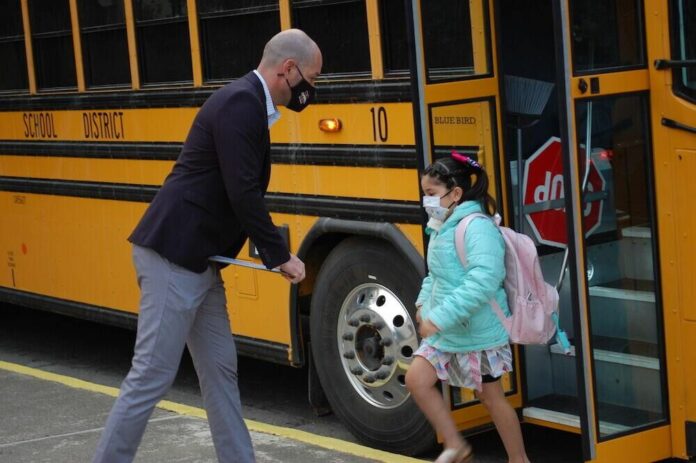Amid the surge of the highly transmissible omicron variant, the Healdsburg Unified School District (HUSD) has been seeing higher than usual absence rates. District administrators are hopeful that new California Department of Public Health (CDPH) guidance on COVID contact tracing and quarantining in schools will allow more students to stay in school.
“Our attendance rate has taken a huge dip over the last week and a half,” HUSD Superintendent Chris Vanden Heuvel said during a Jan. 19 HUSD School Board meeting.
According to Vanden Heuvel, last Thursday, 27% of the students in the district were absent. On Friday, Jan. 14, 29% of district students were absent.
“I’m happy to report that Tuesday and today (Wednesday, Jan. 19) we were at about 17% absent, so it is a good improvement. That said, our normal absence rate is between 4% and 6% so we’re not even close to that yet,” Vanden Heuvel said.
The district’s new quarantine and contact exposure plan, which also applies to school staff, is based on recently updated guidance from the CDPH and Vanden Heuvel said the biggest change in the plan is for the unvaccinated and the ability to stay in school unless there’s an outside exposure.
The new plan, which will be available in English and Spanish, is organized as a flow chart in order to make it easier for parents, students and staff to understand what to do in the event of a positive COVID case or an exposure.
If a student is exposed to a positive COVID case, the first question to ask is, “Is the student fully vaccinated and/or had a confirmed COVID case within the last 90 days?” Students 18 and up are considered fully vaccinated after being fully updated on their shots, meaning they’ve received their initial two shots and a booster shot. If you are a student under 18, fully vaccinated means you’ve had two shots.
If the answer to the question is “Yes,” there are no restrictions and the student may return to school. The student should test between three to five days after the exposure and monitor for symptoms 10 days after the confirmed exposure.
If the answer to the question is “No, the student is not fully vaccinated,” then the course of action depends on whether the COVID positive exposure occurred at school or outside of school.
If the exposure took place at school, then that student is eligible for a modified quarantine. Modified quarantine means a student without symptoms may remain at school, but should test between three to five days after the exposure. The student may also participate in extracurricular activities including sports, but they must monitor for symptoms for 10 days after exposure.
Students who were exposed to COVID outside of school must enter into a full quarantine. They must quarantine for five days (Day 1 begins after the last day of exposure). If the student tests negative on day 5, or later, they can return to school the following day. The student should continue to monitor for symptoms for 10 days after exposure and they are required to wear a surgical or medical grade, or KN95 mask.
In terms of changes to contact tracing, Vanden Heuvel said the district is going to take a group tracing approach. For instance if there’s a COVID positive case in class, the entire class will be notified about the exposure.
“The shift in this group tracing approach is really an emphasis in testing. Instead of spending all of that painstaking time in the individual contact tracing, we’re doing a lot more testing of students,” Vanden Heuvel said.
Testing
Another change is that the district is switching to antigen testing. Vanden Heuvel said while they do still have access to PCR testing, antigen tests yield much quicker results.
The district received testing kits from the state in an effort to test kids prior to their return to school after winter break. The district received the kits the Wednesday after school resumed and deployed those out to families.
“We received quite a few positive tests out of that and we started contact tracing and that was really the onset of omicron, and so we’ve been dealing with that at a rapid pace over the last two weeks,” Vanden Heuvel said.
Testing options for students continue Monday through Friday, 8 to 11:30 a.m., at Healdsburg High School outside behind the district office. Individual school site testing, PCR and antigen testing, is also available.
Vanden Heuvel said at this time, the district does not have the capacity to test every single student who wants to be tested.
He said the focus is on testing students who have symptoms and on students who are trying to return to school after having COVID.
New health order on gatherings
Last week, a new county health order prohibiting indoor gatherings of more than 50 people and outdoor gatherings of more than 100 people went into effect. The order will remain in place until Feb. 11.
And while the order has an effect on local performing arts venues and concerts, the order also affects school sports and performing arts.
For sports games only 50 people, including the coaches, players and referees, are allowed inside, effectively limiting any spectators.
Vanden Heuvel said he and other county superintendents penned a letter to Sonoma County Health Office Dr. Sundari Mase regarding sports and performing arts attendees in order to try and find a middle ground compromise that still ensures the safety of all, but allows for some semblance of community normalcy for students.
“News may come out in the next few days, we are hopeful. It’s been a good conversation (with Mase),” Vanden Heuvel said.









